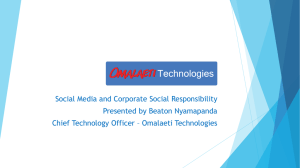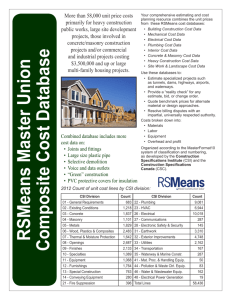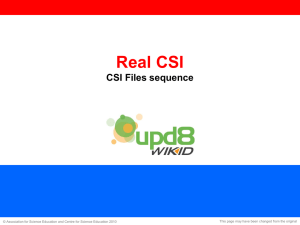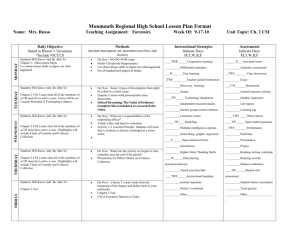materials
advertisement
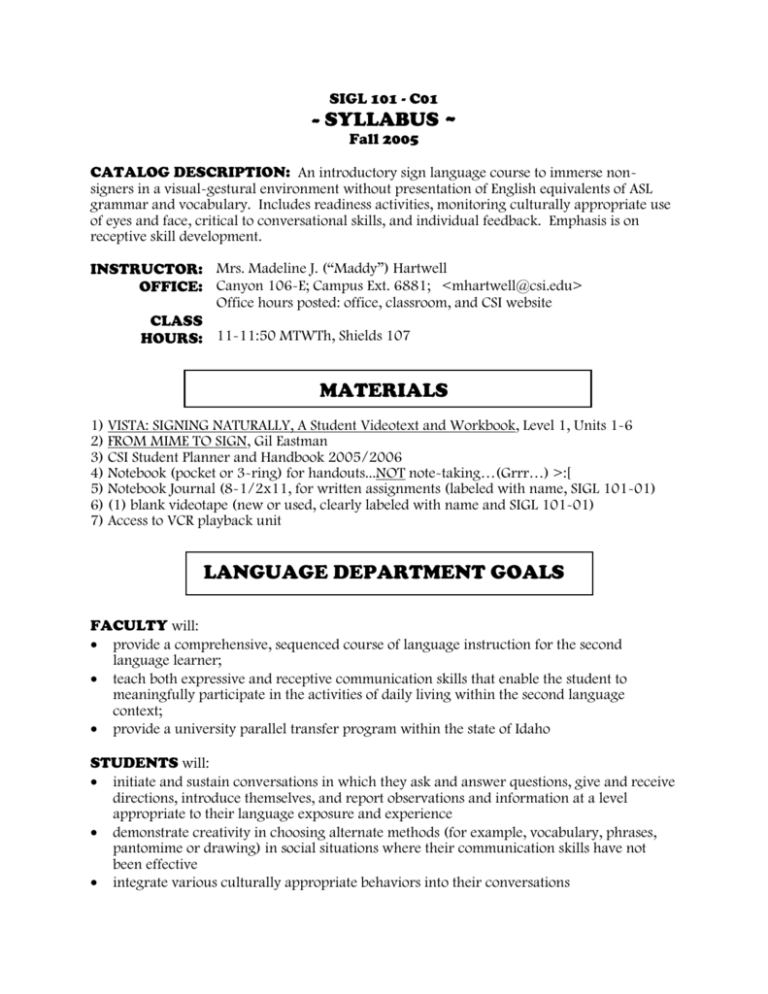
SIGL 101 - C01 ~ SYLLABUS Fall 2005 ~ CATALOG DESCRIPTION: An introductory sign language course to immerse nonsigners in a visual-gestural environment without presentation of English equivalents of ASL grammar and vocabulary. Includes readiness activities, monitoring culturally appropriate use of eyes and face, critical to conversational skills, and individual feedback. Emphasis is on receptive skill development. INSTRUCTOR: Mrs. Madeline J. (“Maddy”) Hartwell OFFICE: Canyon 106-E; Campus Ext. 6881; <mhartwell@csi.edu> Office hours posted: office, classroom, and CSI website CLASS HOURS: 11-11:50 MTWTh, Shields 107 MATERIALS 1) VISTA: SIGNING NATURALLY, A Student Videotext and Workbook, Level 1, Units 1-6 2) FROM MIME TO SIGN, Gil Eastman 3) CSI Student Planner and Handbook 2005/2006 4) Notebook (pocket or 3-ring) for handouts...NOT note-taking…(Grrr…) >:[ 5) Notebook Journal (8-1/2x11, for written assignments (labeled with name, SIGL 101-01) 6) (1) blank videotape (new or used, clearly labeled with name and SIGL 101-01) 7) Access to VCR playback unit LANGUAGE DEPARTMENT GOALS FACULTY will: provide a comprehensive, sequenced course of language instruction for the second language learner; teach both expressive and receptive communication skills that enable the student to meaningfully participate in the activities of daily living within the second language context; provide a university parallel transfer program within the state of Idaho STUDENTS will: initiate and sustain conversations in which they ask and answer questions, give and receive directions, introduce themselves, and report observations and information at a level appropriate to their language exposure and experience demonstrate creativity in choosing alternate methods (for example, vocabulary, phrases, pantomime or drawing) in social situations where their communication skills have not been effective integrate various culturally appropriate behaviors into their conversations FEATURES OF INSTRUCTION readiness activities incidental learning vocabulary expansion incidental grammar social use of the language receptive skill development creating events in a context direct method of instruction (no spoken English) promoting a safe learning environment feedback and evaluation of student achievement second language acquisition strategies (adult education) introducing culturally appropriate use of eyes, face, body GRADING GUIDELINES ATTENDANCE A = 0-4 days missed, on-time for class B = 5-7 days missed, on-time for class C = 5-7 days missed and/or chronically late, chronically leaving early Instructor Drop = 8 days missed HOMEWORK AND WORKBOOK ASSIGNMENTS (written, drawn, collected, made) A = dependably high quality, complete, on-time B = usually high quality, complete, on-time C = noticeably incomplete, late, lack of quality D = incomplete, not made-up within unit of study DEMONSTRATION of “CIVIL BEHAVIOR” IN THE CLASSROOM (see student list) A = faithfully civil, readily demonstrates culturally appropriate behavior B = usually civil, rarely needs reminders for culturally appropriate behavior C = frequently passive and/or rarely demonstrates culturally appropriate behavior D = lack of culturally appropriate behavior and/or reminders become a distraction PARTICIPATION (active movement, demonstrates initiative, works well with a variety of partners, is self-directed in activities, makes and keeps appointments) A = self-directed, daily, readily, dependable, spontaneously (est. 90% of the time) B = usually, regularly, with some encouragement (est. 80% of the time) C = occasionally, rarely self-directed, requires encouragement (est. 70% of the time) D = significantly lacks self-direction, requires invitation (est. 60% of the time) INDIVIDUAL FEEDBACK ~ scheduled with instructor A = 2 ….. (1) by mid-term B = 2 ….. after mid-term C = 1 ….. after mid-term D = 1 or more no-show appointments NOTE: Students must take the OA and achieve 65% accuracy to secure an earned grade. PLAGIARISM ~ See CSI Catalog 2003-2004, p. ____ or Student Planner & Handbook, p. ____ STUDENT DISABILITY SERVICES: “Any student with a documented disability may be eligible for related accommodations. To determine eligibility and secure services, students should contact the coordinator of Disability Services at their first opportunity after registration for a class. Student disability Services is located in the Taylor Building of the Twin Falls campus.” Phone: 208-732-6250 or 208-734-9929 (TTY) E-MAIL contact: Ann Flannery, Coordinator <aflannery@csi.edu> CELL PHONES: All electronic devices (cell phones, pagers, palm pilots and the like) must be rendered “unavailable” during class time. No in-coming calls. No checking for calls. OUTCOMES ASSESSMENT: Students will respond on paper with pencil and crayons, as directed in ASL. 1) Directions for the test, if not written on the test paper, will be given in ASL as a portion of their assessment. 2) Test items will be presented in ASL twice…NO MORE…without benefit of instruction or clarification in English. 3) The test material will comprehensively cover RECEPTIVE LANGUAGE SKILLS of materials presented during the semester. Students must achieve a score of 65% or better on the OA to secure an earned grade of A, B or C, which enables them to take ASL 2. A score less than 65% will earn a student no better than a D. Students who are not available to take the OA can earn no better than a D unless previous arrangements are available and negotiated with the instructor. No alternative is currently available. -------------------------------------------Detach Here -------------------------------------- I have read and heard the information in the course syllabus. I have clarified what I needed to know about it, and will take personal and academic responsibility for its contents. NAME_________________________________________________ DATE__________________ SIGL 101 - C02 ~ SYLLABUS Fall 2005 ~ CATALOG DESCRIPTION: An introductory sign language course to immerse nonsigners in a visual-gestural environment without presentation of English equivalents of ASL grammar and vocabulary. Includes readiness activities, monitoring culturally appropriate use of eyes and face, critical to conversational skills, and individual feedback. Emphasis is on receptive skill development. INSTRUCTOR: Mrs. Madeline J. (“Maddy”) Hartwell OFFICE: Canyon 106-E; Campus Ext. 6881; <mhartwell@csi.edu> Office hours posted: office, classroom, and CSI website CLASS HOURS: 12-12:50 MTWTh, Shields 107 MATERIALS 1) VISTA: SIGNING NATURALLY, A Student Videotext and Workbook, Level 1, Units 1-6 2) FROM MIME TO SIGN, Gil Eastman 3) CSI Student Planner and Handbook 2004/2005 4) Notebook (pocket or 3-ring) for handouts...NOT note-taking…(Grrr…) >:[ 5) Notebook Journal (8-1/2x11, for written assignments (labeled with name, SIGL 101-02) 6) (1) blank videotape (new or used, clearly labeled with name and SIGL 101-02) 7) Access to VCR playback unit LANGUAGE DEPARTMENT GOALS FACULTY will: provide a comprehensive, sequenced course of language instruction for the second language learner; teach both expressive and receptive communication skills that enable the student to meaningfully participate in the activities of daily living within the second language context; provide a university parallel transfer program within the state of Idaho STUDENTS will: initiate and sustain conversations in which they ask and answer questions, give and receive directions, introduce themselves, and report observations and information at a level appropriate to their language exposure and experience demonstrate creativity in choosing alternate methods (for example, vocabulary, phrases, pantomime or drawing) in social situations where their communication skills have not been effective integrate various culturally appropriate behaviors into their conversations SIGL 101 - C03 ~ SYLLABUS Fall 2005 ~ CATALOG DESCRIPTION: An introductory sign language course to immerse nonsigners in a visual-gestural environment without presentation of English equivalents of ASL grammar and vocabulary. Includes readiness activities, monitoring culturally appropriate use of eyes and face, critical to conversational skills, and individual feedback. Emphasis is on receptive skill development. INSTRUCTOR: Mrs. Madeline J. (“Maddy”) Hartwell OFFICE: Canyon 106-E; Campus Ext. 6881; <mhartwell@csi.edu> Office hours posted: office, classroom, and CSI website CLASS HOURS: 2-2:50 MTWTh, Shields 107 MATERIALS 1) VISTA: SIGNING NATURALLY, A Student Videotext and Workbook, Level 1, Units 1-6 2) FROM MIME TO SIGN, Gil Eastman 2) CSI Student Planner and Handbook 2004/2005 3) Notebook (pocket or 3-ring) for handouts...NOT note-taking…(Grrr…) >:[ 4) Notebook Journal (8-1/2x11, for written assignments (labeled with name, SIGL 101-03) 5) (1) blank videotape (new or used, clearly labeled with name and SIGL 101-03) 7) Access to VCR playback unit LANGUAGE DEPARTMENT GOALS FACULTY will: provide a comprehensive, sequenced course of language instruction for the second language learner; teach both expressive and receptive communication skills that enable the student to meaningfully participate in the activities of daily living within the second language context; provide a university parallel transfer program within the state of Idaho STUDENTS will: initiate and sustain conversations in which they ask and answer questions, give and receive directions, introduce themselves, and report observations and information at a level appropriate to their language exposure and experience demonstrate creativity in choosing alternate methods (for example, vocabulary, phrases, pantomime or drawing) in social situations where their communication skills have not been effective integrate various culturally appropriate behaviors into their conversations SIGL 101 - C04 ~ SYLLABUS Fall 2005 ~ CATALOG DESCRIPTION: An introductory sign language course to immerse nonsigners in a visual-gestural environment without presentation of English equivalents of ASL grammar and vocabulary. Includes readiness activities, monitoring culturally appropriate use of eyes and face, critical to conversational skills, and individual feedback. Emphasis is on receptive skill development. INSTRUCTOR: Mrs. Madeline J. (“Maddy”) Hartwell OFFICE: Canyon 106-E; Campus Ext. 6881; <mhartwell@csi.edu> Office hours posted: office, classroom, and CSI website CLASS HOURS: 4-4:50 MTWTh, Canyon 106 MATERIALS 1) VISTA: SIGNING NATURALLY, A Student Videotext and Workbook, Level 1, Units 1-6 2) FROM MIME TO SIGN, Gil Eastman 2) CSI Student Planner and Handbook 2004/2005 3) Notebook (pocket or 3-ring) for handouts...NOT note-taking…(Grrr…) >:[ 4) Notebook Journal (8-1/2x11, for written assignments (labeled with name, SIGL 101-03) 5) (1) blank videotape (new or used, clearly labeled with name and SIGL 101-03) 7) Access to VCR playback unit LANGUAGE DEPARTMENT GOALS FACULTY will: provide a comprehensive, sequenced course of language instruction for the second language learner; teach both expressive and receptive communication skills that enable the student to meaningfully participate in the activities of daily living within the second language context; provide a university parallel transfer program within the state of Idaho STUDENTS will: initiate and sustain conversations in which they ask and answer questions, give and receive directions, introduce themselves, and report observations and information at a level appropriate to their language exposure and experience demonstrate creativity in choosing alternate methods (for example, vocabulary, phrases, pantomime or drawing) in social situations where their communication skills have not been effective integrate various culturally appropriate behaviors into their conversations




